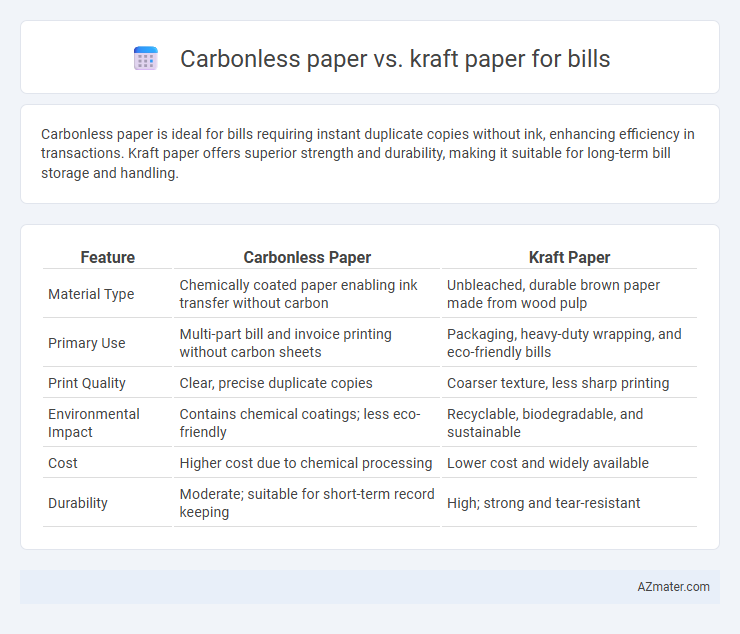Carbonless paper is ideal for bills requiring instant duplicate copies without ink, enhancing efficiency in transactions. Kraft paper offers superior strength and durability, making it suitable for long-term bill storage and handling.
Table of Comparison
| Feature | Carbonless Paper | Kraft Paper |
|---|---|---|
| Material Type | Chemically coated paper enabling ink transfer without carbon | Unbleached, durable brown paper made from wood pulp |
| Primary Use | Multi-part bill and invoice printing without carbon sheets | Packaging, heavy-duty wrapping, and eco-friendly bills |
| Print Quality | Clear, precise duplicate copies | Coarser texture, less sharp printing |
| Environmental Impact | Contains chemical coatings; less eco-friendly | Recyclable, biodegradable, and sustainable |
| Cost | Higher cost due to chemical processing | Lower cost and widely available |
| Durability | Moderate; suitable for short-term record keeping | High; strong and tear-resistant |
Understanding Carbonless Paper: Features and Uses
Carbonless paper, also known as NCR (No Carbon Required) paper, is designed to transfer information written on the top sheet to subsequent sheets without using carbon paper, making it ideal for multi-part forms like invoices and bills. Its micro-encapsulated dye and reactive clay layers enable clean, instant copies, enhancing efficiency in billing processes. This paper type offers superior convenience and professional appearance compared to traditional Kraft paper, which is thicker and mainly valued for durability rather than legibility or carbonless copying.
Kraft Paper: Composition, Advantages, and Limitations
Kraft paper, made from wood pulp through the kraft process, is renowned for its high tensile strength and durability, making it ideal for bills requiring robust handling and shipping resistance. Its natural brown color and environmentally friendly attributes, including biodegradability and recyclability, offer sustainability advantages over carbonless paper, which contains chemical coatings for instant duplicate creation. Limitations of kraft paper include reduced smoothness affecting print clarity and the absence of self-copying capabilities, which necessitates manual duplication or additional equipment for billing processes.
Bill Printing Requirements: What Businesses Need
Carbonless paper provides businesses with instant duplicate or triplicate bill copies without using ink, essential for retail and service industries requiring quick, clear records. Kraft paper offers durability and eco-friendliness, suitable for businesses needing sturdy, recyclable billing materials that withstand handling and shipping. Choosing between carbonless and kraft paper depends on the volume of bill printing, the need for duplicate copies, and environmental considerations.
Carbonless Paper for Bills: Efficiency and Clarity
Carbonless paper is ideal for bills due to its ability to create multiple copies without carbon sheets, enhancing efficiency in transaction documentation. It ensures clear, legible duplicates, reducing errors and improving record-keeping for businesses. This paper's chemical coating transfers writing instantly, streamlining billing processes and minimizing manual labor.
Kraft Paper for Billing: Eco-Friendliness and Appeal
Kraft paper for billing stands out due to its eco-friendliness, being fully biodegradable and often made from recycled fibers, which reduces environmental impact compared to carbonless paper that contains chemical coatings. Its natural brown texture offers a rustic, authentic appeal that enhances brand identity and customer perception. The durability and strength of Kraft paper ensure bills remain intact during handling and mailing, making it a preferred choice for sustainable and visually appealing invoices.
Durability Comparison: Carbonless vs. Kraft Paper
Carbonless paper offers moderate durability, suitable for short-term use with its ability to create multiple copies without impact damage, while Kraft paper excels in toughness and tear resistance, making it ideal for long-term storage and rough handling. Carbonless sheets can lose clarity if exposed to moisture or heat, whereas Kraft paper maintains structural integrity under various environmental conditions. For billing purposes requiring longevity and physical durability, Kraft paper provides a more resilient option compared to the delicate nature of carbonless paper.
Cost Analysis: Which Paper Saves More?
Carbonless paper reduces the need for carbon sheets, lowering overall expenses in multi-part billing processes, while Kraft paper offers durability but often comes at a higher cost per sheet due to its thicker material and strength. For high-volume billing, carbonless paper typically saves more by streamlining printing and handling costs, whereas Kraft paper may incur additional expenses related to storage and transport because of its weight. Evaluating cost per unit alongside usage requirements is essential to determine which paper type achieves better savings in billing applications.
Environmental Impact: Sustainability of Both Papers
Carbonless paper, often coated with chemicals to transfer images without ink, poses challenges for recycling and can release harmful substances during decomposition, impacting environmental sustainability. Kraft paper, made from wood pulp using a less chemically intensive process, is biodegradable and widely recycled, making it a more eco-friendly choice for billing materials. Choosing kraft paper supports sustainable forestry practices and reduces chemical waste, aligning better with eco-conscious business operations.
User Experience: Readability and Handling
Carbonless paper enhances readability for bills by eliminating the need for carbon sheets, producing clear, smudge-free copies instantly, which improves user convenience during handling and record-keeping. Kraft paper, known for its durability and rough texture, offers a tactile, sturdy feel but can compromise print clarity, making detailed bill information harder to read. Users handling carbonless paper benefit from its smooth surface and legible output, while Kraft paper suits environments prioritizing robustness over print precision.
Choosing the Best Paper for Your Billing Needs
Carbonless paper offers efficient multi-part bill creation without the need for carbon sheets, ensuring clear and instant duplicate copies ideal for transaction records and invoices. Kraft paper provides durability and a rustic, eco-friendly appearance, perfect for businesses seeking a robust and sustainable billing solution. Choosing between carbonless and kraft paper depends on the priority of copy clarity versus paper strength and environmental considerations in your billing process.

Infographic: Carbonless paper vs Kraft paper for Bill
 azmater.com
azmater.com